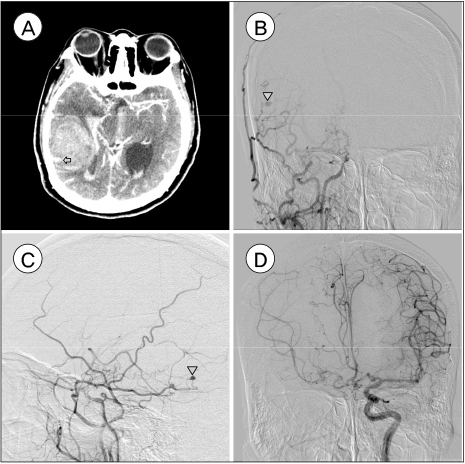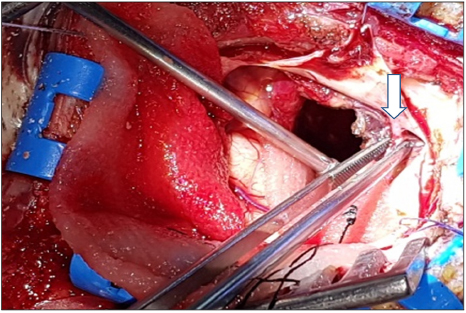J Cerebrovasc Endovasc Neurosurg.
2018 Sep;20(3):187-190. 10.7461/jcen.2018.20.3.187.
Rupture of a Middle Meningeal Artery Pseudoaneurysm in Moyamoya Syndrome Related with Tuberculous Meningitis
- Affiliations
-
- 1Department of Neurosurgery, Chung-Ang University Hospital, Chung-Ang University College of Medicine, Seoul, Korea. nsnam@cau.ac.kr
- KMID: 2422771
- DOI: http://doi.org/10.7461/jcen.2018.20.3.187
Abstract
- We report a rare case of a patient with Moyamoya syndrome who presented with intracerebral hemorrhage resulting from rupture of a middle meningeal artery pseudoaneurysm. This 38-year-old woman was unconscious and hemiplegic when she was admitted to our hospital. The patient had mental retardation as a result of tuberculous meningitis infection at the age of one year. On radiologic examination, she had intracerebral hemorrhage in the right temporo-parietal lobe and an aneurysm in the middle meningeal artery with right internal carotid artery occlusion. The patient underwent surgical treatment for the hemorrhage and aneurysm. The radiologic data, intraoperative findings, and pathology were consistent with a diagnosis of pseudoaneurysm. In the current report, we describe a rare case of a patient with a history of tuberculous meningitis who developed Moyamoya syndrome and pseudoaneurysm, which resulted in a ruptured middle meningeal artery pseudoaneurysm and brain hemorrhage.
MeSH Terms
Figure
Reference
-
1. Borota L, Marinkovic S, Bajic R, Kovacevic M. Intracranial aneurysms associated with moyamoya disease. Neurol Med Chir (Tokyo). 996; 12. 36(12):860–864.
Article2. Hamada J, Hashimoto N, Tsukahara T. Moyamoya disease with repeated intraventricular hemorrhage due to aneurysm rupture. Report of two cases. J Neurosurg. 1994; 02. 80(2):328–331.3. Koebbe CJ, Horowitz MB. A rare case of a ruptured middle meningeal aneurysm causing intracerebral hematoma in a patient with moyamoya disease. AJNR Am J Neuroradiol. 2004; 04. 25(4):574–576.4. Kuroda S, Houkin K, Kamiyama H, Abe H. Effects of surgical revascularization on peripheral artery aneurysms in moyamoya disease: report of three cases. Neurosurgery. 2001; 08. 49(2):463–467.
Article5. Mathew NT, Abraham J, Chandy J. Cerebral angiographic features in tuberculous meningitis. Neurology. 1970; 10. 20(10):1015–1023.
Article6. Matsukawa H, Fujii M, Murakata A, Shinoda M, Takahashi O. Foramen spinosum and middle meningeal artery in moyamoya disease: preliminary results of a pilot study. Brain Inj. 2015; 06. 29(10):1246–1251.
Article7. Nakayama Y, Tanaka A, Nagasaka S, Ikui H. Intracerebral hemorrhage in a patient with moyamoya phenomenon caused by tuberculous arteritis: a case report. No Shinkei Geka. 1999; 08. 27(8):751–755.8. Park YS, Suk JS, Kwon JT. Repeated rupture of a middle meningeal artery aneurysm in moyamoya disease: case report. J Neurosurg. 2010; 10. 113(4):749–752.9. Phi JH, Wang KC, Lee JY, Kim SK. Moyamoya syndrome: a window of moyamoya disease. J Korean Neurosurg Soc. 2015; 06. 57(6):408–414.
Article10. Pinardi F, Stracciari A, Spinardi L, Guarino M. Postpneumococcal Moyamoya syndrome case report and review of the postinfective cases. BMJ Case Rep. 2013; 02. 2013:bcr2012006726.
Article11. Sadatoh A, Yonekawa Y, Morooka Y, Imakita T. A case of moyamoya disease with repeated intraventricular hemorrhage due to a ruptured pseudoaneurysm. No Shinkei Geka. 1989; 08. 17(8):755–758.12. Scott RM, Smith ER. Moyamoya disease and moyamoya syndrome. N Engl J Med. 2009; 03. 360(12):1226–1237.
Article13. Torok ME. Tuberculous meningitis: advances in diagnosis and treatment. Br Med Bull. 2015; 03. 113(1):117–131.
Article14. Zipfel GJ, Fox DJ Jr, Rivet DJ. Moyamoya disease in adults: the role of cerebral revascularization. Skull Base. 2005; 02. 15(1):27–41.
Article
- Full Text Links
- Actions
-
Cited
- CITED
-
- Close
- Share
- Similar articles
-
- Moyamoya Syndrome Following Tuberculous Meningitis
- Angiographically Progressive Change of Traumatic Pseudoaneurysm Arising from the Middle Meningeal Artery
- A Case of Moyamoya Syndrome Associated with Hereditary Spherocytosis
- Intracerebral Hematoma Caused by Ruptured Traumatic Pseudoaneurysm of the Middle Meningeal Artery: A Case Report
- Studies on Total Cholesterol Level in Cerebrospinal Fluids of Tuberculous and Purulent Meningitis in Children




